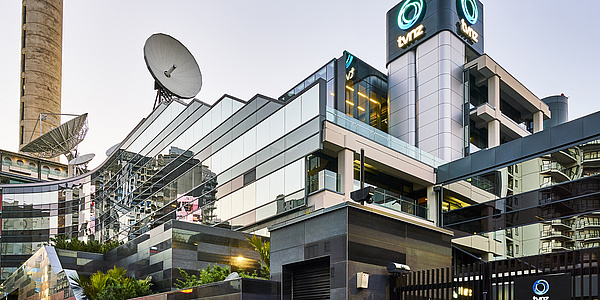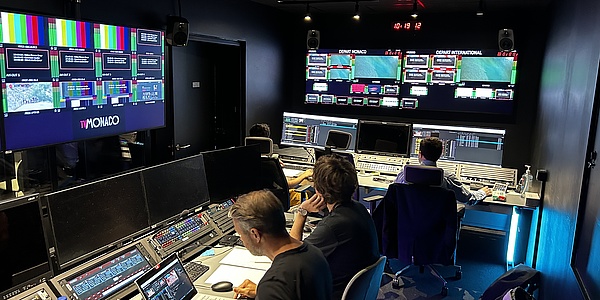
Qvestions & Answers: The “Asharq News” Project
“IP-based broadcast infrastructures are becoming more and more like traditional IT in terms of development cycles.”
In a technically and organizationally impressive project, Qvest has made the multi-platform broadcaster Asharq News in Dubai ready for the future of broadcasting. In the Qvestions & Answers interview, Philipp Glänzel, General Manager & CTO of Qvest in the MENA region, explains how Asharq News is now setting standards in the news workflow.
Qvestions & Answers: The interview about the "Asharq News" project
Qvestion: Mr. Glänzel, you are responsible for Qvest’s technology projects for the Middle East and North Africa from the Dubai location. What are the special challenges in the MENA region?
Philipp Glänzel: With several years of project experience in the MENA region, I would not necessarily relate the challenge to the region as such, but rather to what lies ahead. Together with Ahmad Hadi Al Kayal, our General Manager & CSO for the region, we will continue to expand the Dubai site in the coming years. We are increasingly relying in the process on the potential of local resources, which we want to promote in a targeted manner in order to further expand our role as a system integrator, service and support provider, and technology consultant.
Qvestion: Qvest designed and implemented the newsroom for the news and media hub Asharq News. What did you have to consider during planning with regard to the technical infrastructure?
At the time of project planning and implementation, the question of whether to build conventional infrastructure had not yet arisen. Since this was a greenfield installation and there were no migration scenarios to consider, it quickly became clear to us that such a measure on the customer side should only be implemented with state-of-the-art technologies in order to create a future-proof infrastructure.
Qvestion: What specific technical components did you and your team choose to make Asharq News fit for the future?
The decision to rely on a 100 GBit/s full IP network and standards such as SMPTE ST 2110, NMOS IS-04 as well as IS-05 had already been specifically made by our Qvest infrastructure design. The use of industry standards such as NMOS over proprietary integrations makes sense to keep the infrastructure compatible, open and upgradeable in the long term. Because even after the project is completed, the customer wants to be able to expand its infrastructure with additional technology solutions. With NMOS, this is possible without having to invest in additional proprietary drivers.
Qvestion: To what extent is this essential, especially with regard to the interaction of very different industry solutions?
This project in particular has shown us how far the implementation of the industry standards SMPTE ST 2110 and NMOS has really progressed at the manufacturers. To put it plainly: Just because it says NMOS and ST 2110 everywhere, doesn’t mean the same thing is inside. It still depends very much on the subtleties of the implemented standard and how the respective manufacturer interprets the standard definition. We paid very close attention to this with our Qvest team.

We are already observing that the IP-based broadcast infrastructure is increasingly adapting to the development cycles from classic IT.
Qvestion: Did the different implementation standards result in additional challenges for the project?
Various challenges arose in the course of the project, which is not unusual, especially with such complexity as in this case here. For example, normalizing the different implementations and establishing a common understanding between the manufacturers of the technology components and us as the orchestrating system integrator. In the end, however, we have an infrastructure implementation that is largely based on NMOS and SMPTE ST 2110 and also implements these standards in a future-proof manner. A key benefit for the many employees at Asharq News is that they are integrated into the news workflow of the studios in Dubai, Abu Dhabi, Cairo and Riyadh, regardless of location - i.e. remotely.
Qvestion: Why do you think remote production is becoming increasingly relevant?
Remote production has certainly become much more important in the recent past. On the one hand, of course, this is due to social distancing and the simultaneous maintenance of production and broadcasting operations. On the other hand are the basic technical advantages offered by remote production. This is because the application stack we implemented for news production allows large parts of Asharq News’ news workflow to be implemented remotely. This is supported by the technologies we have integrated into the broadcaster’s corporate IT network. Specifically, the studio in Riyadh allows for remote production in the traditional sense, thus allowing the Asharq News team to fully control this studio from Dubai.
Qvestion: Can you already give an outlook on what other projects Qvest will be tackling in the MENA region in the near future?
We have identified some potential infrastructure projects in the region that have similar requirements to the one we have here at Asharq News. We are very well prepared for this with our interdisciplinary Qvest team, as we have gained valuable experience on worldwide projects. We want to and will bring this knowledge back to the region in the future. In the current developments of the technology, we are already observing that the IP-based broadcast infrastructure is increasingly adapting to the development cycles from classic IT.
Qvestion: So you assume that broadcast infrastructures will develop in a similar way to the classic IT sector?
Definitely! Even within a few months we could observe a shift from 10G to 25G endpoints. This more than doubles the bandwidth requirement in the backend network. At Qvest, we expect this trend to continue in line with traditional IT. For us, this means that we will implement agile infrastructures with our “best-of-breed” approach so that our customers can adapt to the ever-changing demands of editing and production and remain up-to-date.







